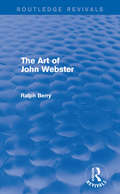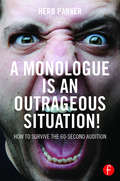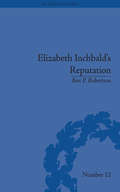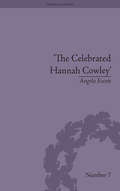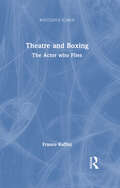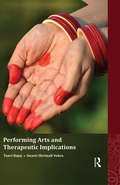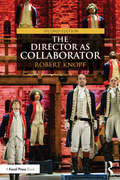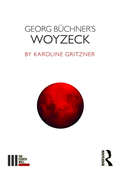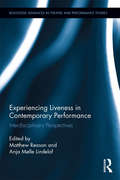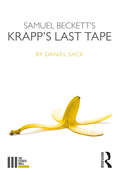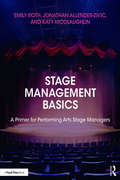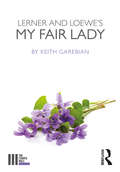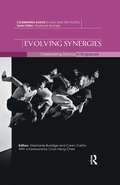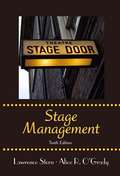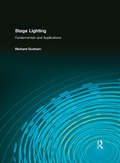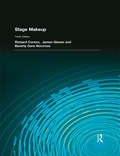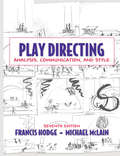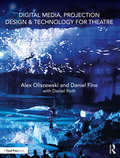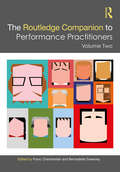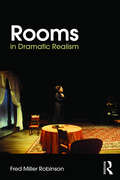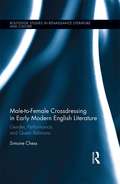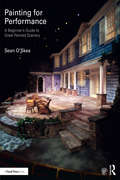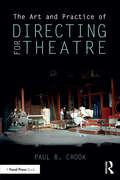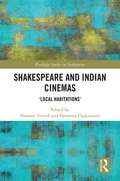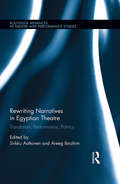- Table View
- List View
The Art of John Webster (Routledge Revivals)
by Ralph BerryThe Art of John Webster, first published in 1972, is a study of the three extant plays of Webster known to be solely his work. These plays are seen as attempts to achieve in literature the effects of the baroque, a term which related Webster to the larger developments of European art. Their content is analysed in terms of a consistent opposition between evil and the law. The book seeks to re-establish a base for the claims that must be made for Webster as a serious artist. This title will be of interest to students of literature and drama.
A Monologue is an Outrageous Situation!: How to Survive the 60-Second Audition
by Herb ParkerA Monologue is an Outrageous Situation! How to Survive the 60-Second Audition explains how to successfully tackle the "cattle call" acting audition with a sixty-second monologue. Through Q&As, tips, director’s notes, and a glossary full of outrageous actions meant to inspire the actor into truly connecting with the piece, this book shows actors where and how to find a monologue, edit it, and give the best audition possible.
Elizabeth Inchbald's Reputation: A Publishing and Reception History (The History of the Book #12)
by Ben P RobertsonThrough an examination of her complete works and public response to them, Robertson gauges the extent of Inchbald's reputation as the dignified Mrs Inchbald, as well as providing a clear sense of what it meant to be a female Romantic writer.
The Celebrated Hannah Cowley: Experiments in Dramatic Genre, 1776–1794 (Gender and Genre)
by Angela EscottHannah Cowley (1743–1809) was a very successful dramatist, and something of an eighteenth-century celebrity. New critical interest in the drama of this period has meant a resurgence of interest in Cowley’s writing and in the performance of her plays. This is the first substantial monograph study to examine Cowley’s life and work.
Theatre and Boxing: The Actor who Flies (Routledge Icarus)
by Franco RuffiniTheatre and Boxing focuses on a problem which is of paramount importance for any theatre practitioner and researcher: the actor’s believable body. This problem has been taken up by Stanislavski, Meyerhold, Artaud, Brecht, Decroux, Copeau, Grotowski, and many others. It is an essential hurdle for all who practice the theatrical craft or want to study it theoretically. This hurdle can be considered one of the foundations of theatre science and of the relationship between technique, politics and ethics. This book tells the story of a revolution in the work of the actor in the early- and mid-20th century, a period in which the focus of theatrical interest shifted from the emotions to the body. The actor’s body became a tool for purveying a dynamic set of actions which often transformed the very actor himself. This new centrality of the body also drew attention to those places in which the body is central: the gym, the boxing ring and the circus with its trapezes and tightropes became, together with the stage, laboratories for the theatre. Thus, in addition to the reformers of the theatre the pages of this book are filled with boxers, acrobats, gymnasts and wrestlers, pursuers of an utopia: the "actor who flies".
Performing Arts and Therapeutic Implications
by Tanvi Bajaj Swasti Shrimali VohraPresenting an alternative perspective, this book proposes that performing arts forge an emotional bond between the performer and the audience, making the act of performance a therapeutic and restorative experience, and not merely recreational. Studying the life-experiences of six artists, and their unique engagement with three art forms — music, drama and dance — the book highlights the physical, emotional, mental, and spiritual effects of performing arts both on the performers and the audience. More importantly, it takes the current understanding of the therapeutic role of arts beyond a deficit model of health that focuses on their use in curing illnesses, disabilities and imbalances, towards a more positive growth-centric model that relates them to promoting holistic mental health, well-being and happiness. It thus bridges the gap between the theoretical understanding of creative arts therapy and the practical experience of performing arts in non-therapeutic settings. Further, it assumes increasing relevance with respect to fast-changing lifestyles to which stress and ill-health are often attributed. The book will appeal to artists, educators and researchers of performing arts, applied psychology, counselling and therapy, and cultural studies, as well as interested general readers.
The Director as Collaborator
by Robert KnopfThe Director as Collaborator teaches essential directing skills while emphasizing how directors and theater productions benefit from collaboration. Good collaboration occurs when the director shares responsibility for the artistic creation with the entire production team, including actors, designers, stage managers, and technical staff. Leadership does not preclude collaboration; in theater, these concepts can and should be complementary. Students will develop their abilities by directing short scenes and plays and by participating in group exercises. New to the second edition: updated interviews, exercises, forms, and appendices new chapter on technology including digital research, previsualization and drafting programs, and web-sharing sites new chapter on devised and ensemble-based works new chapter on immersive theater, including material and exercises on environmental staging and audience–performer interaction
Georg Büchner's Woyzeck (The Fourth Wall)
by Karoline Gritzner'Everyone's an abyss. You get dizzy if you look down.' -- Woyzeck Georg Büchner’s Woyzeck was left unfinished at the time of its author’s death in 1837, but the play is now widely recognised as the first ‘modern’ drama in the history of European theatre. Its fragmentary form and critical socio-political content have had a lasting influence on artists, readers and audiences to this day. The abuse, exploitation, and disenfranchisement that Woyzeck’s titular protagonist endures find their mirror in his own murderous outburst. But beyond that, they also echo in the flux and confusion of the various drafts and versions in which the play has been presented since its emergence. In this fresh engagement with a modern classic, Gritzner examines the revolutionary dimensions of Büchner’s political and creative practice, as well as modern approaches to the play in performance.
Experiencing Liveness in Contemporary Performance: Interdisciplinary Perspectives (Routledge Advances in Theatre & Performance Studies)
by Matthew Reason Anja Mølle LindelofThis volume brings together dynamic perspectives on the concept of liveness in the performing arts, engaging with the live through the particular analytical focus of audiences and experience. The status and significance of the live in performance has become contested: perceived as variously as a marker of ontological difference, a promotional slogan, or a mystical evocation of cultural value. Moving beyond debates about the relationship between the live and the mediated, this collection considers what we can know and say about liveness in terms of processes of experiencing and processes of making. Drawing together contributions from theatre, music, dance, and performance art, it takes an interdisciplinary approach in asking not what liveness is, but how it matters and to whom. The book invites readers to consider how liveness is produced through processes of audiencing - as spectators bring qualities of (a)liveness into being through the nature of their attention - and how it becomes materialized in acts of performance, acts of making, acts of archiving, and acts of remembering. Theoretical chapters and practice-based reflections explore liveness, eventness and nowness as key concepts in a range of topics such as affect, documentation, embodiment, fandom, and temporality, showing how the relationship between audience and event is rarely singular and more often malleable and multiple. With its focus on experiencing liveness, this collection will be of interest to disciplines including performance, audience and cultural studies, visual arts, cinema, and sound technologies.
Samuel Beckett's Krapp's Last Tape (The Fourth Wall)
by Daniel Sack"We lay there without moving. But under us all moved, and moved us." - Krapp Samuel Beckett’s most accessible play is also one of the twentieth century’s most moving dramas about aging, memory, and disappointment. Daniel Sack offers the first comprehensive survey of Krapp’s Last Tape (1958) with a general reader in mind. Structured around a series of questions, five approachable sections contextualize the play in the larger career of its Nobel-Prize-winning writer, explore its major thematic concerns, and offer comparative analyses with Beckett’s other signal works. Sack also uses discussions of significant productions, including those directed by the playwright himself, to ground interpretation of the play in terms of its performance and provide a useful resource to directors and actors. Both a critical and personal exploration of this haunting play, this volume is a must-read for anyone with an interest in Beckett’s work.
Stage Management Basics: A Primer for Performing Arts Stage Managers
by Emily Roth Jonathan Allender-Zivic Katy McGlaughlinWithout assuming any intrinsic prior knowledge of the theatrical field and its associated, specialized terminology, Stage Management Basics covers every aspect of the stage management, from reading a script, meeting with a director and theatre staff, and auditioning, to constructing green digital scripts, communication best practices, and opening night protocol. Additionally, this book features multiple appendices containing stage management form templates, blank version of which are available on its companion website. This book touches on basic principles for stage management for theatre, dance, and opera productions.
Lerner and Loewe's My Fair Lady (The Fourth Wall)
by Keith Garebian"An Englishman's way of speaking absolutely classifies him,The moment he talks he makes some other Englishman despise him." - Henry George Bernard Shaw famously refused to permit any play of his "to be degraded into an operetta or set to any music except its own." Allowing his beloved Pygmalion to be supplanted by a comic opera was therefore unthinkable; yet Lerner and Loewe transformed it into My Fair Lady (1956), a musical that was to delight audiences and critics alike. By famously reversing Shaw’s original ending, the show even dared to establish a cunningly romantic ending. Keith Garebian delves into the libretto for a fresh take, and explores biographies of the show’s principal artists to discover how their roles intersected with real life. Rex Harrison was an alpha male onstage and off, Julie Andrews struggled with her ‘chaste diva’ image, and the direction of the sexually ambiguous Moss Hartcontributed to the musical’s sexual coding.
Evolving Synergies: Celebrating Dance in Singapore (Celebrating Dance in Asia and the Pacific)
by Stephanie Burridge Caren CariñoA comprehensive overview of the dance culture of Singapore, this book embodies storytelling, personal reflections, memories, and histories of the artists. The extensive calendar of events encompassing companies and soloists from diverse dance practices, such as Indian, Malay and Chinese and a variety of Western contemporary dances, underline Singapore as a vibrant player in the evolution of Asian culture.
Stage Management
by Alice R. O'Grady Lawrence SternRevered as the authoritative resource for stage management, this text offers students a practical manual on how to stage manage in all theater environments. Rich with practical resources -- checklists, diagrams, examples, forms and step-by-step directions -- Stage Management eschews excessive discussion of philosophy and gets right to the essential materials and processes of putting on a production. In addition to sharing his own expertise, Stern has gathered practical advice from working stage managers of Broadway, off-Broadway, touring companies, regional, community, and 99-seat Equity waiver theaters.
Stage Lighting: Fundamentals and Applications
by Richard E. DunhamThe book’s organization follows a layered approach that builds on basic principles: Light as a Medium (Part 1), Tools of a Lighting Designer (Part 2), Design Fundamentals (Part 3), and Lighting Applications (Part 4). This presents students with a practical and logical sequence when learning basic concepts. The full spectrum of the lighting design process is presented in detail, giving students an example of how one might develop a lighting design from script analysis through concept and plot development, and all the way to an opening. This detailed process with a step-by-step design approach gives students a plan to work from, which they can later modify as they mature and gain confidence as designers. The text contains a more comprehensive discussion of basic technology, light as a physical phenomena, and methodology of designs than is found in most introductory texts, bridging the gap between introductory and advanced lighting courses. The text will appeal to theatrical designers who want to venture into areas of lighting like architectural or virtual lighting design, while at the same time gaining a solid grounding in the fundmentals of lighting design. Lighting Design will also benefit illuminating engineers who want to move away from mere computational approaches in lighting and on to explore techniques along the design approaches of theatrical lighting design. The final 9 chapters cover many specialty areas of lighting design, highlighting the unique and shared qualities that exist between the different aspects of these elements. Discussions involve traditional entertainment areas like theatre, as well as lesser known facets of the industry including film/video, landscape lighting, retail/museum lighting, virtual lighting, concert, spectacle performances, and architectural lighting. Models of design tasks demonstrate the actual use and development of plots/sections, schedules, photometrics tables, and cut sheets, rather than simply talking about what they are. This hands-on approach provides students with a firm understanding of how to actually use these tools and processes.
Stage Makeup
by Richard Corson James Glavan Beverly Gore NorcrossWidely referred to as the “bible of stage makeup,” the timely revision of this classic text addresses principles and techniques in the use of makeup for the contemporary performer. This extensive exploration of the application and use of stage makeup and makeup for a variety of performance venues covers all aspects in detail and contains over 400 photographs, drawings, and diagrams demonstrating step-by-step procedures. Thoroughly updated and revised, this classic text remains accurate and comprehensive, providing information from which all readers – whether students to the field or seasoned, professional makeup artists – will benefit. New to this edition: Updated photography throughout. Features the latest information on products and techniques throughout. New additions to chapters concerning hairpieces and wigs: making a pattern for a beard and mustache, making a pattern for a wig, fronting a wig, or sending accurate information for rentals, and the basic roller set for wigs. The source Appendix has been totally updated with new vendors and the latest website addresses. The materials Appendix has had the most current products added. There are new, blank makeup charts for class work and designing makeups. There is a color guide for a two-part silicone life cast. The new color section featuring Academy Award nominee, Christien Tinsley, steps for the Tinsley Transfers for cuts, bruises and prosthetics. (As seen in the movie The Passion Of The Christ.) A selection of makeup in color with complete instructions. Color photos of Academy Award winner, Matthew Mungle, special effects makeup for the CSI television show. Instructions for a new “creating a likeness” of Queen Elizabeth I. The Film and Television chapter now includes information about working with the latest HD digital technology. The color section now includes a series of photos illustrating the effects of gel colors on natural makeup.
Play Directing: Analysis, Communication, and Style
by Michael Mclain Francis HodgePlay Directing describes the various roles a director plays, from selection and analysis of the play, to working with actors and designers to bring the production to life.
Digital Media, Projection Design, and Technology for Theatre
by Alex Oliszewski Daniel Fine Daniel RothDigital Media, Projection Design, and Technology for Theatre covers the foundational skills, best practices, and real-world considerations of integrating digital media and projections into theatre. The authors, professional designers and university professors of digital media in live performance, provide readers with a narrative overview of the professional field, including current industry standards and expectations for digital media/projection design, its related technologies and techniques. The book offers a practical taxonomy of what digital media is and how we create meaning through its use on the theatrical stage. The book outlines the digital media/projection designer’s workflow into nine unique phases. From the very first steps of landing the job, to reading and analyzing the script and creating content, all the way through to opening night and archiving a design. Detailed analysis, tips, case studies, and best practices for crafting a practical schedule and budget, to rehearsing with digital media, working with actors and directors, to creating a unified design for the stage with lighting, set, sound, costumes, and props is discussed. The fundamentals of content creation, detailing the basic building blocks of creating and executing digital content within a design is offered in context of the most commonly used content creation methods, including: photography and still images, video, animation, real-time effects, generative art, data, and interactive digital media. Standard professional industry equipment, including media servers, projectors, projection surfaces, emissive displays, cameras, sensors, etc. is detailed. The book also offers a breakdown of all key related technical tasks, such as converging, warping, and blending projectors, to calculating surface brightness/luminance, screen size and throw distance, to using masks, warping content and projection mapping, making this a complete guide to digital media and projection design today. An eResource page offers sample assets and interviews that link to current and relevant work of leading projection designers.
The Routledge Companion to Performance Practitioners: Volume Two (Routledge Companions)
by Franc Chamberlain; Bernadette SweeneyThe Routledge Companion to Performance Practitioners collects the outstanding biographical and production overviews of key theatre practitioners first featured in the popular Routledge Performance Practitioners series of guidebooks. Each of the chapters is written by an expert on a particular figure, from Stanislavsky and Brecht to Laban and Decroux, and places their work in its social and historical context. Summaries and analyses of their key productions indicate how each practitioner's theoretical approaches to performance and the performer were manifested in practice. All 22 practitioners from the original series are represented, with this volume covering those born after 1915. This is the definitive first step for students, scholars and practitioners hoping to acquaint themselves with the leading names in performance, or deepen their knowledge of these seminal figures.
Rooms in Dramatic Realism
by Fred Miller RobinsonDramatic Realism, since its birth in the hectic late years of the nineteenth century, gave theatrical and thematic energy to the interaction between a play's text and the way that it looked on the stage. Characters began to find themselves in rooms and settings that played an active and changing role in the drama, and their dialogue and reactions evolved in time with these changes. As life itself became more elaborate during the 20th Century, so these rooms were invaded and then defined by the outside world. Fred Miller Robinson's enjoyable and stimulating essays on this enduring genre tackle the dreams and anxieties of the middles classes of the Industrial Revolution - dreams of domestic comfort and refuge, and anxieties about how entrapping that comfort could be. Moving from Ibsen to Chekhov and onwards into later plays in which the reality of 'Realism' comes under scrutiny, this is a book to dip into before a performance or to study during a class.
Male-to-Female Crossdressing in Early Modern English Literature: Gender, Performance, and Queer Relations (Routledge Studies in Renaissance Literature and Culture)
by Simone ChessThis volume examines and theorizes the oft-ignored phenomenon of male-to-female (MTF) crossdressing in early modern drama, prose, and poetry, inviting MTF crossdressing episodes to take a fuller place alongside instances of female-to-male crossdressing and boy actors’ crossdressing, which have long held the spotlight in early modern gender studies. The author argues that MTF crossdressing episodes are especially rich sources for socially-oriented readings of queer gender—that crossdressers’ genders are constructed and represented in relation to romantic partners, communities, and broader social structures like marriage, economy, and sexuality. Further, she argues that these relational representations show that the crossdresser and his/her allies often benefit financially, socially, and erotically from his/her queer gender presentation, a corrective to the dominant idea that queer gender has always been associated with shame, containment, and correction. By attending to these relational and beneficial representations of MTF crossdressers in early modern literature, the volume helps to make a larger space for queer, genderqueer, male-bodied and queer-feminine representations in our conversations about early modern gender and sexuality.
Painting for Performance: A Beginner’s Guide to Great Painted Scenery
by Sean O'SkeaPainting for Performance removes the mystery from painting and gives beginners the terms, tools, and techniques to approach their unpainted set with confidence. Covering the mechanics of paint and its many implementations in set design, this book provides simple and effective step-by-step instructions for painting a variety of surfaces to look great on stage.
The Art and Practice of Directing for Theatre
by Paul B. CrookThe formation and communication of vision is one of the primary responsibilities of a director, before ever getting to the nuts and bolts of the process. The Art and Practice of Directing for Theatre helps the young director learn how to discover, harness, and meld the two. Providing both a practical and theoretical foundation for directors, this book explores how to craft an artistic vision for a production, and sparks inspiration in directors to put their learning into practice. This book includes: Guidance through day-to-day aspects of directing, including a director’s skillset and tools, script analysis, and rehearsal structure. Advice on collaborating with production teams and actors, building communication skills and tools, and integrating digital media into these practices. Discussion questions and practical worksheets covering script analysis, blocking, and planning rehearsals, with downloadable versions on a companion website.
Shakespeare and Indian Cinemas: "Local Habitations" (Routledge Studies in Shakespeare)
by Poonam Trivedi Paromita ChakravartiThis book is the first to explore the rich archive of Shakespeare in Indian cinemas, including less familiar, Indian language cinemas to contribute to the assessment of the expanding repertoire of Shakespeare films worldwide. Essays cover mainstream and regional Indian cinemas such as the better known Tamil and Kannada, as well as the less familiar regions of the North Eastern states. The volume visits diverse filmic genres, starting from the earliest silent cinema, to diasporic films made for global audiences, television films, independent films, and documentaries, thus expanding the very notion of ‘Indian cinema’ while also looking at the different modalities of deploying Shakespeare specific to these genres. Shakespeareans and film scholars provide an alternative history of the development of Indian cinemas through its negotiations with Shakespeare focusing on the inter-textualities between Shakespearean theatre, regional cinema, performative traditions, and literary histories in India. The purpose is not to catalog examples of Shakespearean influence but to analyze the interplay of the aesthetic, historical, socio-political, and theoretical contexts in which Indian language films have turned to Shakespeare and to what purpose. The discussion extends from the content of the plays to the modes of their cinematic and intermedial translations. It thus tracks the intra–Indian flows and cross-currents between the various film industries, and intervenes in the politics of multiculturalism and inter/intraculturalism built up around Shakespearean appropriations. Contributing to current studies in global Shakespeare, this book marks a discursive shift in the way Shakespeare on screen is predominantly theorized, as well as how Indian cinema, particularly ‘Shakespeare in Indian cinema’ is understood.
Rewriting Narratives in Egyptian Theatre: Translation, Performance, Politics (Routledge Advances in Theatre & Performance Studies)
by Sirkku Aaltonen Areeg IbrahimThis study of Egyptian theatre and its narrative construction explores the ways representations of Egypt are created of and within theatrical means, from the 19th century to the present day. Essays address the narratives that structure theatrical, textual, and performative representations and the ways the rewriting process has varied in different contexts and at different times. Drawing on concepts from Theatre and Performance Studies, Translation Studies, Cultural Studies, Postcolonial Studies, and Diaspora Studies, scholars and practitioners from Egypt and the West enter into dialogue with one another, expanding understanding of the different fields. The articles focus on the ways theatre texts and performances change (are rewritten) when crossing borders between different worlds. The concept of rewriting is seen to include translation, transformation, and reconstruction, and the different borders may be cultural and national, between languages and dramaturgies, or borders that are present in people’s everyday lives. Essays consider how rewritings and performances cross borders from one culture, nation, country, and language to another. They also study the process of rewriting, the resulting representations of foreign plays on stage, and representations of the Egyptian revolution on stage and in Tahrir Square. This assessment of the relationship between theatre practices, exchanges, and rewritings in Egyptian theatre brings vital coverage to an undervisited area and will be of interest to developments in theatre translation and beyond.
